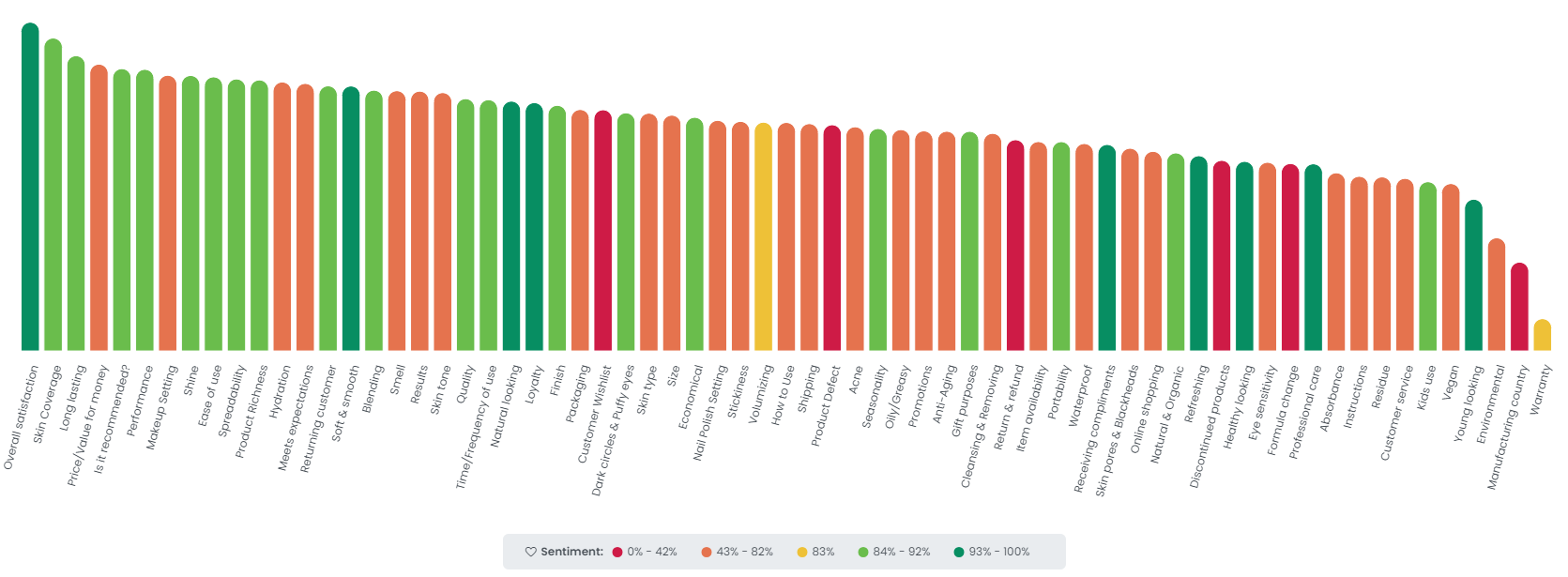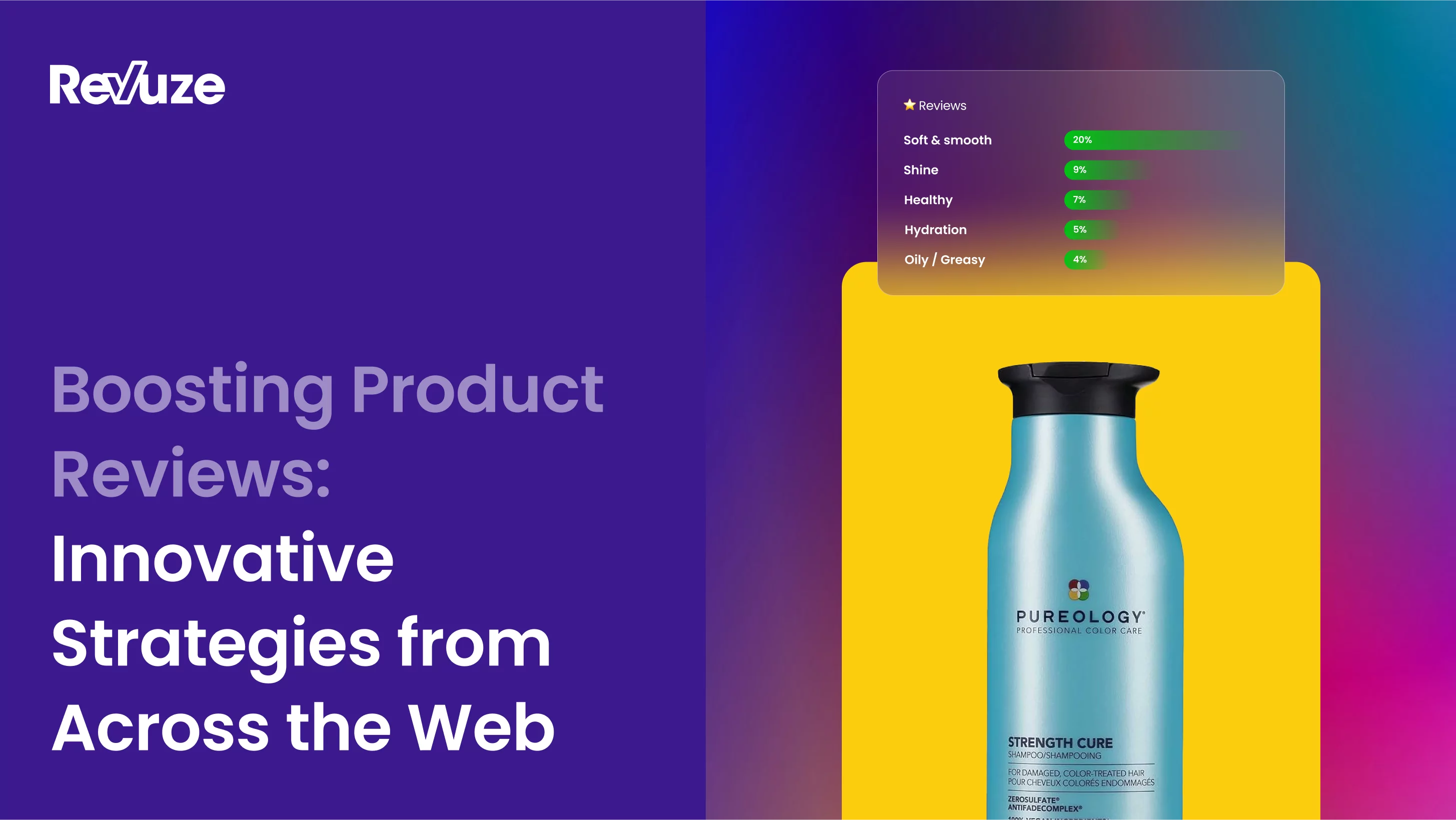
Sentiment analysis is the benchmark which brands use to measure satisfaction. It answers the question about whether consumers love or hate your brand. To some extent, brands can garner sentiment from popular social listening tools which quantify reactions, engagements, and hashtags. However consumer listening provides an added dimension by capturing sentiment on the product level from consumer reviews. This addition comes directly from consumers who actually purchased your product!
Sounds simple enough, right? Performing a sentiment analysis on consumer reviews is tougher than you might realize. Consumers who write a review may not write about one aspect of your product. In fact, most reviews are quite lengthy and touch upon numerous topics relating to product attributes. And there may be a different sentiment for each one.
A look at consumer reviews
Earlier we discussed how consumer feedback can mention various product attributes making sentiment analysis somewhat complex. To better understand the challenge, let’s have a look at some genuine reviews from different industries.
Cosmetics
“Super easy to apply and blend as they are a smooth creamy almost whipped texture. The pay off and pigmentation is insanely good and is so bright and pretty on the day. My only qualm is the staying power, a good base on the eye is needed to make the product really stick but other than that it’s perfect!” Eyes to Mesmerise Cream Eyeshadow
The review above about the Charlotte Tilbury eyeshadow discusses a few product attributes. While most of the topics have a positive association, one is negative:
- Application: Positive
- Blending: Positive
- Color/Pigmentation: Positive
- Long-lasting: Negative
- Overall Satisfaction: Positive
Home Electronics
“The purple color is so pretty! But I was trying to decide between these and Apple pro. These unfortunately were not comfortable for me. The pros are better for smaller ears. The sound was great, though!” Beats Fit Pro True Wireless Earbuds
In this review the consumer is comparing the purchased item, the Beats Fit Pro to the Apple AirPods Pro. Again, we see that the consumer touches on a number of topics with different sentiments:
- Color: Positive
- Fit: Negative
- Sound Quality: Negative
Food & Beverage
“This bag is so full I couldn’t reseal the bag until baking some brownies – the little amount I took out at first wasn’t enough to create room to zip the bag closed. The flavor is good, it seems fresh, and a great value. Another good product from Yerbero.” Yerbero Oaxacan Cacao Powder
Similar to the reviews from other vertical above, this consumer feedback relates to a number of product aspects:
- Packaging: Negative
- Flavor: Positive
- Freshness: Positive
- Price/Value for Money: Positive
On the face of it, extracting sentiment from reviews seems simple enough. However, this exercise focused on three reviews from different verticals. Each review referenced at least three different product topics which were assigned their own sentiment. Also consider, we didn’t even touch the various online retailers. Think about the hundreds or thousands of reviews from Amazon, Target, Walmart for each category – all making reviews a big data challenge.
The Power of Category Insights
As discussed earlier, performing a sentiment analysis on an entire product category is a tremendous hurdle. There could be thousands of products and brands in a given category. Plus, each product could have hundreds or thousands of reviews, depending on how far back the data goes. To monitor trends, it’s best to look at 24 months worth of data.
The benefit of category insights are the following three levels of sentiment analysis:
- Brand sentiment
- Product sentiment
- Topic sentiment for various product attributes
Empowered with the various dimensions of sentiment for the category, marketers and innovators can leverage the data to make critical business decisions.
Consumer Reviews in Action
The need for brand sentiment is easy to understand, right? You want to understand what consumers think about your brand. The same is true for product sentiment–it’s important to understand what consumers think of your products. If your consumer base loves your products, you’re in a great position in the marketplace. However, if you’re in the middle, or on the low end of consumer sentiment, it will serve you well to understand what’s impacting consumer sentiment on a high level. The qualitative data that consumer reviews provide is unparalleled. Again, given the quantity of reviews, it may not be possible to dive into every single one!
That’s where topic sentiment analysis comes in. By calculating the sentiment for various topics mentioned by reviews, brands can quickly and easily pinpoint their strengths and weaknesses to pursue business decisions.
For instance, the chart below highlights ~60 topics that emerged from consumer reviews across the entire cosmetics category. Each topic is color-coded to reflect consumer sentiment. What immediately emerges is that there are five areas with very low sentiment: “Customer Wishlist”, “Product Defect”, “Return & Refund”, “Discontinued Products”, and “Manufacturing Country”. Given the picture, it’s important to dive into the reviews themselves to identify the issues that consumers are facing.
Once the issues have been sliced and diced, it’s time to take action! Topics like “Customer Wishlist”, “Product Defect”, and “Discontinued Products” can spur product innovation for companies. For instance, “Customer Wishlist” literally can create a roadmap for the next iterations of your product. Similarly, given the backlash from loyal customers over “Discontinued Products”, it may be time to relaunch old, familiar favorites to satisfy them. In the same vein, “Product Defects” signify challenges with your current product offering. This is an opportunity to fix the challenges with your current product offerings.
For the most part we discussed how sentiment for three topics can support in-house innovation efforts. However, if those topics and low sentiments reflect your competition, this can be an amazing opportunity to come out with a strong marketing campaign to ensure your brand stays top of mind.
The importance of online review analytics platform
Thus far we focused on the different facets of consumer sentiment and how it can be applied to support brands innovation and marketing needs. However, we also talked about the big data challenge of online reviews presents. Think about it–when conducting a survey or focus group, you have a very limited data set. A survey is sent to a predefined list of consumers or potential customers. The same is true of focus groups, where small groups of people are being questioned about their sentiment in a somewhat controlled setting. Though it takes time to distill the insights, the dataset is manageable.
Online reviews are a different animal. The dataset is HUGE! Category insights contains reviews for every brand and product! The only way to ensure the highest degree is to use a consumer insights platform like Revuze to aggregate, cleanse, and analyze the data. Only then will you be able to see topic insights to provide a clear direction for future business decisions.
Conclusion
Sentiment analysis emerges as a crucial tool for brands to understand consumer emotions towards their products on a granular level. The complexity of extracting meaningful insights from lengthy and multifaceted consumer reviews underscores the nuanced nature of this task. Despite the challenges, the ability to dissect reviews into brand, product, and topic sentiments offers invaluable insights that can drive strategic business decisions. Leveraging sophisticated platforms like Revuze to navigate the vast data landscape of online reviews enables brands to identify strengths, address weaknesses, and seize opportunities for innovation and competitive advantage. In essence, sentiment analysis not only provides a direct line to consumer perceptions, but also equips brands with the actionable intelligence needed to thrive and be competitive in today’s dynamic market environment.
 All
Articles
All
Articles Email
Analytics
Email
Analytics











 Agencies
Insights
Agencies
Insights